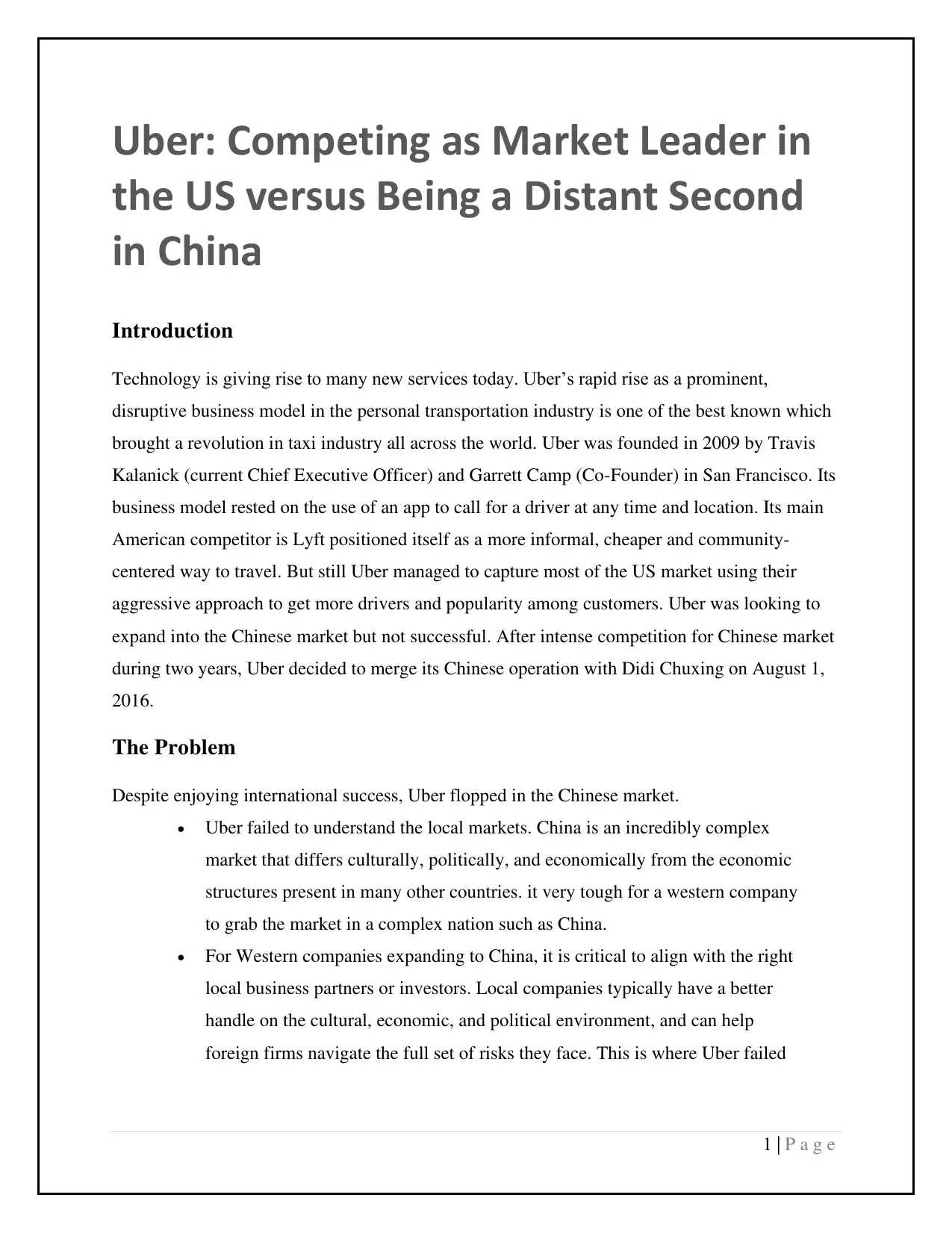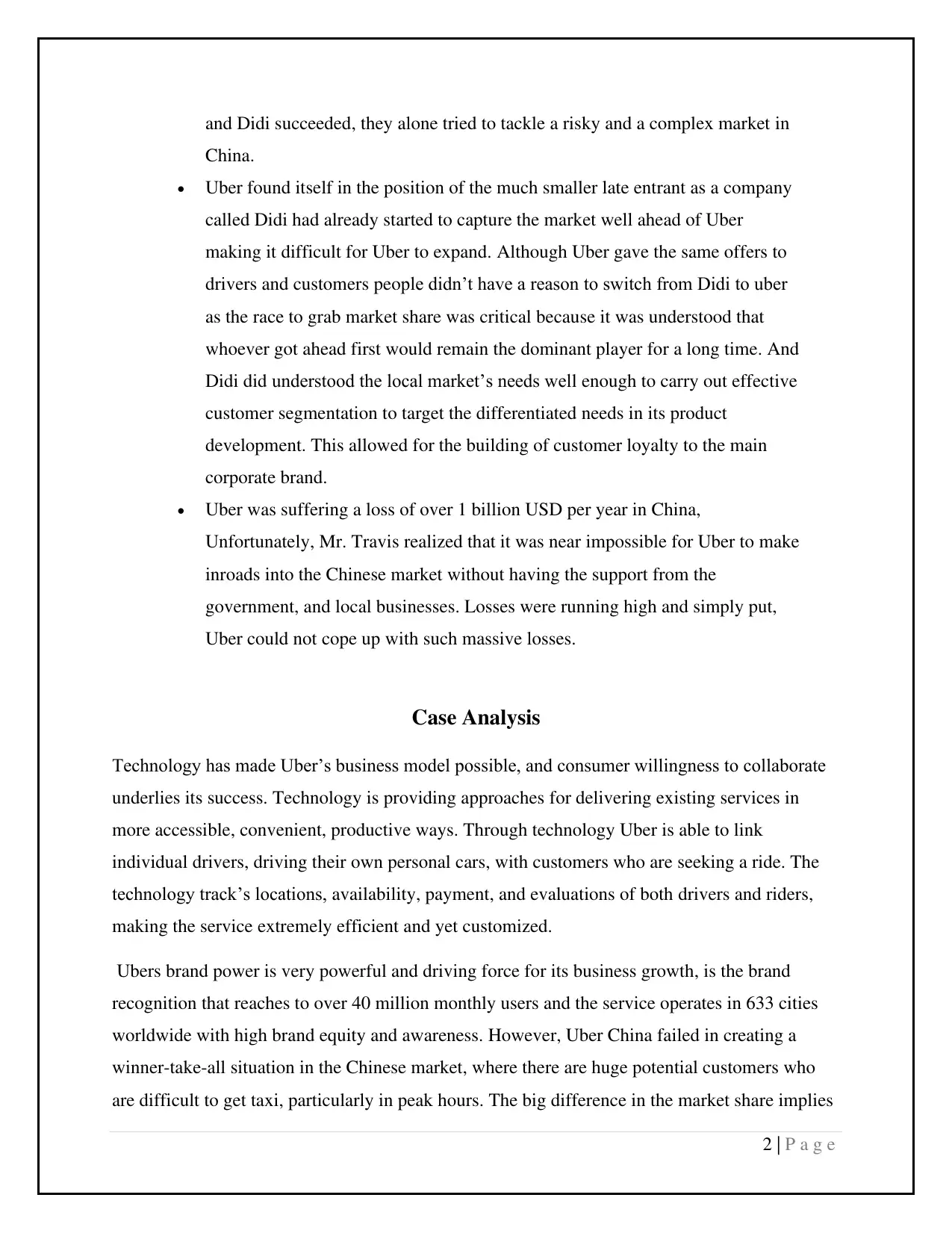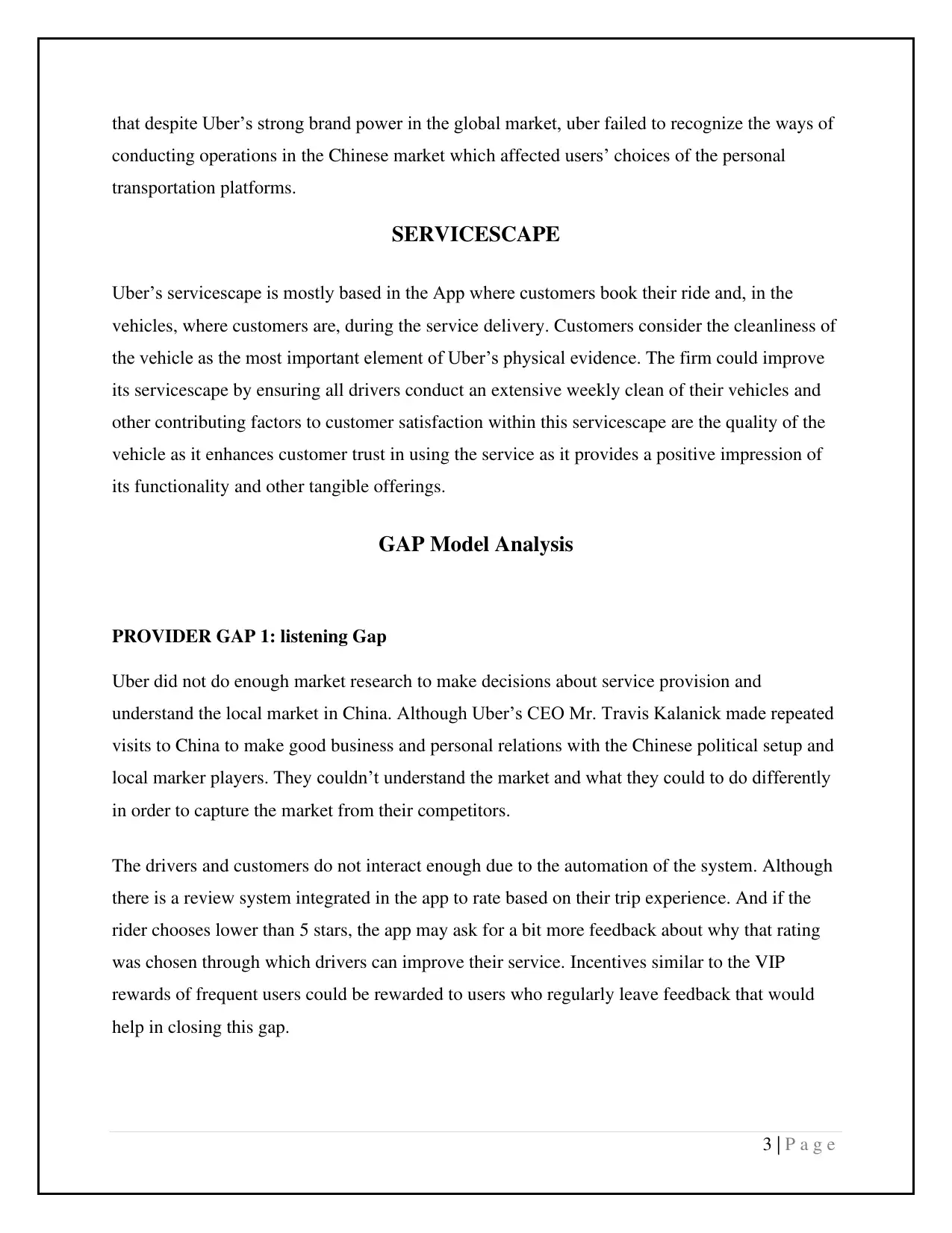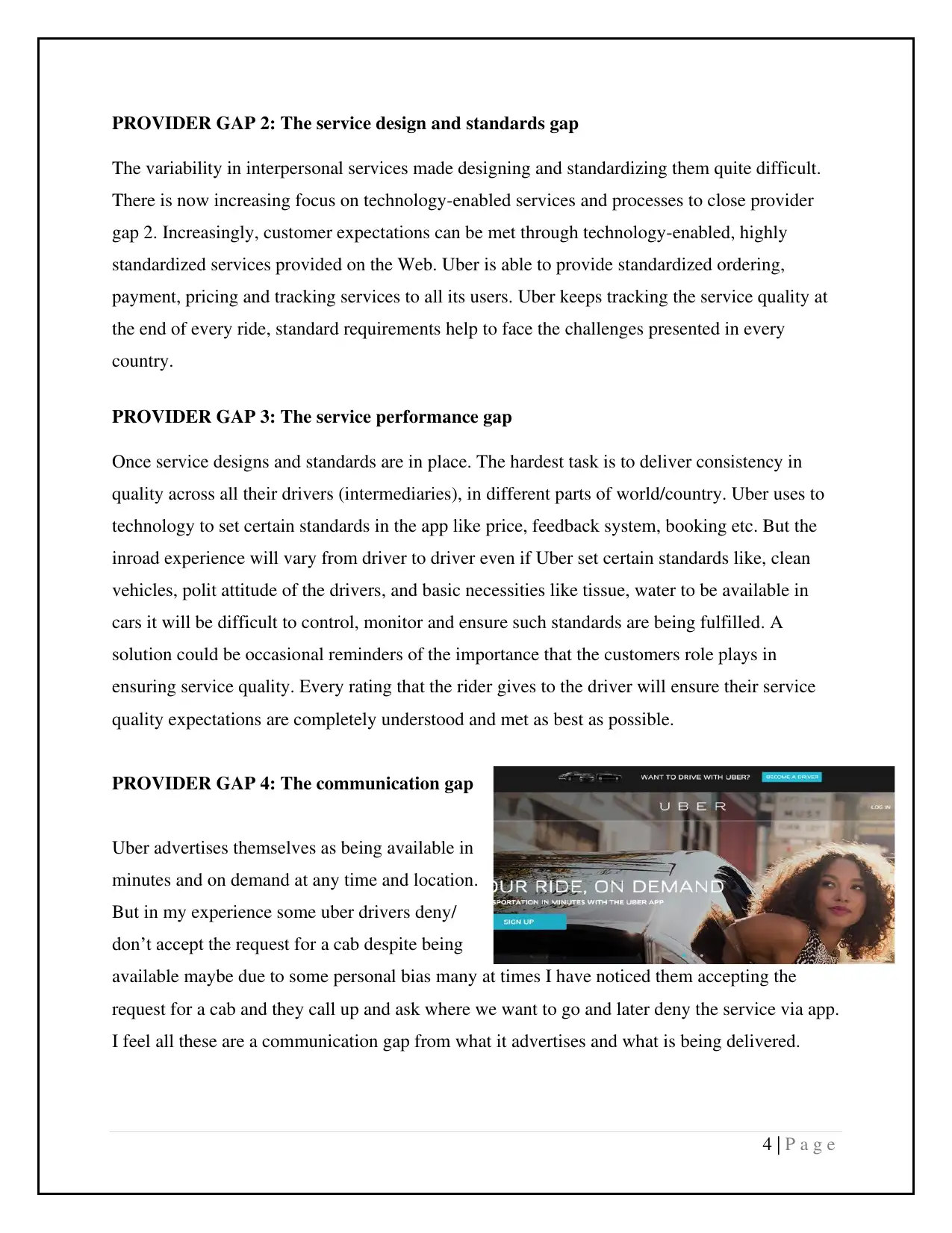Uber's Strategic Challenges: US Success Contrasted with China Failure
VerifiedAdded on 2021/04/09
|4
|1384
|333
Case Study
AI Summary
This case study examines Uber's strategic challenges and contrasting market performances in the United States and China. It explores Uber's successful business model, driven by technology and brand recognition, and contrasts it with its failure to capture a significant share of the Chinese market. The analysis delves into the reasons behind Uber's struggles in China, including a failure to understand the local market, the need for local business partners, and the early dominance of Didi Chuxing. The study also analyzes Uber's servicescape and applies the GAP model to identify and address the listening, service design, performance, and communication gaps that contributed to its challenges in the Chinese market. The case highlights the importance of adapting strategies to local market conditions and the critical role of competition in global expansion.

1 | P a g e
Uber: Competing as Market Leader in
the US versus Being a Distant Second
in China
Introduction
Technology is giving rise to many new services today. Uber’s rapid rise as a prominent,
disruptive business model in the personal transportation industry is one of the best known which
brought a revolution in taxi industry all across the world. Uber was founded in 2009 by Travis
Kalanick (current Chief Executive Officer) and Garrett Camp (Co-Founder) in San Francisco. Its
business model rested on the use of an app to call for a driver at any time and location. Its main
American competitor is Lyft positioned itself as a more informal, cheaper and community-
centered way to travel. But still Uber managed to capture most of the US market using their
aggressive approach to get more drivers and popularity among customers. Uber was looking to
expand into the Chinese market but not successful. After intense competition for Chinese market
during two years, Uber decided to merge its Chinese operation with Didi Chuxing on August 1,
2016.
The Problem
Despite enjoying international success, Uber flopped in the Chinese market.
• Uber failed to understand the local markets. China is an incredibly complex
market that differs culturally, politically, and economically from the economic
structures present in many other countries. it very tough for a western company
to grab the market in a complex nation such as China.
• For Western companies expanding to China, it is critical to align with the right
local business partners or investors. Local companies typically have a better
handle on the cultural, economic, and political environment, and can help
foreign firms navigate the full set of risks they face. This is where Uber failed
Uber: Competing as Market Leader in
the US versus Being a Distant Second
in China
Introduction
Technology is giving rise to many new services today. Uber’s rapid rise as a prominent,
disruptive business model in the personal transportation industry is one of the best known which
brought a revolution in taxi industry all across the world. Uber was founded in 2009 by Travis
Kalanick (current Chief Executive Officer) and Garrett Camp (Co-Founder) in San Francisco. Its
business model rested on the use of an app to call for a driver at any time and location. Its main
American competitor is Lyft positioned itself as a more informal, cheaper and community-
centered way to travel. But still Uber managed to capture most of the US market using their
aggressive approach to get more drivers and popularity among customers. Uber was looking to
expand into the Chinese market but not successful. After intense competition for Chinese market
during two years, Uber decided to merge its Chinese operation with Didi Chuxing on August 1,
2016.
The Problem
Despite enjoying international success, Uber flopped in the Chinese market.
• Uber failed to understand the local markets. China is an incredibly complex
market that differs culturally, politically, and economically from the economic
structures present in many other countries. it very tough for a western company
to grab the market in a complex nation such as China.
• For Western companies expanding to China, it is critical to align with the right
local business partners or investors. Local companies typically have a better
handle on the cultural, economic, and political environment, and can help
foreign firms navigate the full set of risks they face. This is where Uber failed
Paraphrase This Document
Need a fresh take? Get an instant paraphrase of this document with our AI Paraphraser

2 | P a g e
and Didi succeeded, they alone tried to tackle a risky and a complex market in
China.
• Uber found itself in the position of the much smaller late entrant as a company
called Didi had already started to capture the market well ahead of Uber
making it difficult for Uber to expand. Although Uber gave the same offers to
drivers and customers people didn’t have a reason to switch from Didi to uber
as the race to grab market share was critical because it was understood that
whoever got ahead first would remain the dominant player for a long time. And
Didi did understood the local market’s needs well enough to carry out effective
customer segmentation to target the differentiated needs in its product
development. This allowed for the building of customer loyalty to the main
corporate brand.
• Uber was suffering a loss of over 1 billion USD per year in China,
Unfortunately, Mr. Travis realized that it was near impossible for Uber to make
inroads into the Chinese market without having the support from the
government, and local businesses. Losses were running high and simply put,
Uber could not cope up with such massive losses.
Case Analysis
Technology has made Uber’s business model possible, and consumer willingness to collaborate
underlies its success. Technology is providing approaches for delivering existing services in
more accessible, convenient, productive ways. Through technology Uber is able to link
individual drivers, driving their own personal cars, with customers who are seeking a ride. The
technology track’s locations, availability, payment, and evaluations of both drivers and riders,
making the service extremely efficient and yet customized.
Ubers brand power is very powerful and driving force for its business growth, is the brand
recognition that reaches to over 40 million monthly users and the service operates in 633 cities
worldwide with high brand equity and awareness. However, Uber China failed in creating a
winner-take-all situation in the Chinese market, where there are huge potential customers who
are difficult to get taxi, particularly in peak hours. The big difference in the market share implies
and Didi succeeded, they alone tried to tackle a risky and a complex market in
China.
• Uber found itself in the position of the much smaller late entrant as a company
called Didi had already started to capture the market well ahead of Uber
making it difficult for Uber to expand. Although Uber gave the same offers to
drivers and customers people didn’t have a reason to switch from Didi to uber
as the race to grab market share was critical because it was understood that
whoever got ahead first would remain the dominant player for a long time. And
Didi did understood the local market’s needs well enough to carry out effective
customer segmentation to target the differentiated needs in its product
development. This allowed for the building of customer loyalty to the main
corporate brand.
• Uber was suffering a loss of over 1 billion USD per year in China,
Unfortunately, Mr. Travis realized that it was near impossible for Uber to make
inroads into the Chinese market without having the support from the
government, and local businesses. Losses were running high and simply put,
Uber could not cope up with such massive losses.
Case Analysis
Technology has made Uber’s business model possible, and consumer willingness to collaborate
underlies its success. Technology is providing approaches for delivering existing services in
more accessible, convenient, productive ways. Through technology Uber is able to link
individual drivers, driving their own personal cars, with customers who are seeking a ride. The
technology track’s locations, availability, payment, and evaluations of both drivers and riders,
making the service extremely efficient and yet customized.
Ubers brand power is very powerful and driving force for its business growth, is the brand
recognition that reaches to over 40 million monthly users and the service operates in 633 cities
worldwide with high brand equity and awareness. However, Uber China failed in creating a
winner-take-all situation in the Chinese market, where there are huge potential customers who
are difficult to get taxi, particularly in peak hours. The big difference in the market share implies

3 | P a g e
that despite Uber’s strong brand power in the global market, uber failed to recognize the ways of
conducting operations in the Chinese market which affected users’ choices of the personal
transportation platforms.
SERVICESCAPE
Uber’s servicescape is mostly based in the App where customers book their ride and, in the
vehicles, where customers are, during the service delivery. Customers consider the cleanliness of
the vehicle as the most important element of Uber’s physical evidence. The firm could improve
its servicescape by ensuring all drivers conduct an extensive weekly clean of their vehicles and
other contributing factors to customer satisfaction within this servicescape are the quality of the
vehicle as it enhances customer trust in using the service as it provides a positive impression of
its functionality and other tangible offerings.
GAP Model Analysis
PROVIDER GAP 1: listening Gap
Uber did not do enough market research to make decisions about service provision and
understand the local market in China. Although Uber’s CEO Mr. Travis Kalanick made repeated
visits to China to make good business and personal relations with the Chinese political setup and
local marker players. They couldn’t understand the market and what they could to do differently
in order to capture the market from their competitors.
The drivers and customers do not interact enough due to the automation of the system. Although
there is a review system integrated in the app to rate based on their trip experience. And if the
rider chooses lower than 5 stars, the app may ask for a bit more feedback about why that rating
was chosen through which drivers can improve their service. Incentives similar to the VIP
rewards of frequent users could be rewarded to users who regularly leave feedback that would
help in closing this gap.
that despite Uber’s strong brand power in the global market, uber failed to recognize the ways of
conducting operations in the Chinese market which affected users’ choices of the personal
transportation platforms.
SERVICESCAPE
Uber’s servicescape is mostly based in the App where customers book their ride and, in the
vehicles, where customers are, during the service delivery. Customers consider the cleanliness of
the vehicle as the most important element of Uber’s physical evidence. The firm could improve
its servicescape by ensuring all drivers conduct an extensive weekly clean of their vehicles and
other contributing factors to customer satisfaction within this servicescape are the quality of the
vehicle as it enhances customer trust in using the service as it provides a positive impression of
its functionality and other tangible offerings.
GAP Model Analysis
PROVIDER GAP 1: listening Gap
Uber did not do enough market research to make decisions about service provision and
understand the local market in China. Although Uber’s CEO Mr. Travis Kalanick made repeated
visits to China to make good business and personal relations with the Chinese political setup and
local marker players. They couldn’t understand the market and what they could to do differently
in order to capture the market from their competitors.
The drivers and customers do not interact enough due to the automation of the system. Although
there is a review system integrated in the app to rate based on their trip experience. And if the
rider chooses lower than 5 stars, the app may ask for a bit more feedback about why that rating
was chosen through which drivers can improve their service. Incentives similar to the VIP
rewards of frequent users could be rewarded to users who regularly leave feedback that would
help in closing this gap.
⊘ This is a preview!⊘
Do you want full access?
Subscribe today to unlock all pages.

Trusted by 1+ million students worldwide

4 | P a g e
PROVIDER GAP 2: The service design and standards gap
The variability in interpersonal services made designing and standardizing them quite difficult.
There is now increasing focus on technology-enabled services and processes to close provider
gap 2. Increasingly, customer expectations can be met through technology-enabled, highly
standardized services provided on the Web. Uber is able to provide standardized ordering,
payment, pricing and tracking services to all its users. Uber keeps tracking the service quality at
the end of every ride, standard requirements help to face the challenges presented in every
country.
PROVIDER GAP 3: The service performance gap
Once service designs and standards are in place. The hardest task is to deliver consistency in
quality across all their drivers (intermediaries), in different parts of world/country. Uber uses to
technology to set certain standards in the app like price, feedback system, booking etc. But the
inroad experience will vary from driver to driver even if Uber set certain standards like, clean
vehicles, polit attitude of the drivers, and basic necessities like tissue, water to be available in
cars it will be difficult to control, monitor and ensure such standards are being fulfilled. A
solution could be occasional reminders of the importance that the customers role plays in
ensuring service quality. Every rating that the rider gives to the driver will ensure their service
quality expectations are completely understood and met as best as possible.
PROVIDER GAP 4: The communication gap
Uber advertises themselves as being available in
minutes and on demand at any time and location.
But in my experience some uber drivers deny/
don’t accept the request for a cab despite being
available maybe due to some personal bias many at times I have noticed them accepting the
request for a cab and they call up and ask where we want to go and later deny the service via app.
I feel all these are a communication gap from what it advertises and what is being delivered.
PROVIDER GAP 2: The service design and standards gap
The variability in interpersonal services made designing and standardizing them quite difficult.
There is now increasing focus on technology-enabled services and processes to close provider
gap 2. Increasingly, customer expectations can be met through technology-enabled, highly
standardized services provided on the Web. Uber is able to provide standardized ordering,
payment, pricing and tracking services to all its users. Uber keeps tracking the service quality at
the end of every ride, standard requirements help to face the challenges presented in every
country.
PROVIDER GAP 3: The service performance gap
Once service designs and standards are in place. The hardest task is to deliver consistency in
quality across all their drivers (intermediaries), in different parts of world/country. Uber uses to
technology to set certain standards in the app like price, feedback system, booking etc. But the
inroad experience will vary from driver to driver even if Uber set certain standards like, clean
vehicles, polit attitude of the drivers, and basic necessities like tissue, water to be available in
cars it will be difficult to control, monitor and ensure such standards are being fulfilled. A
solution could be occasional reminders of the importance that the customers role plays in
ensuring service quality. Every rating that the rider gives to the driver will ensure their service
quality expectations are completely understood and met as best as possible.
PROVIDER GAP 4: The communication gap
Uber advertises themselves as being available in
minutes and on demand at any time and location.
But in my experience some uber drivers deny/
don’t accept the request for a cab despite being
available maybe due to some personal bias many at times I have noticed them accepting the
request for a cab and they call up and ask where we want to go and later deny the service via app.
I feel all these are a communication gap from what it advertises and what is being delivered.
1 out of 4
Related Documents
Your All-in-One AI-Powered Toolkit for Academic Success.
+13062052269
info@desklib.com
Available 24*7 on WhatsApp / Email
![[object Object]](/_next/static/media/star-bottom.7253800d.svg)
Unlock your academic potential
Copyright © 2020–2025 A2Z Services. All Rights Reserved. Developed and managed by ZUCOL.





